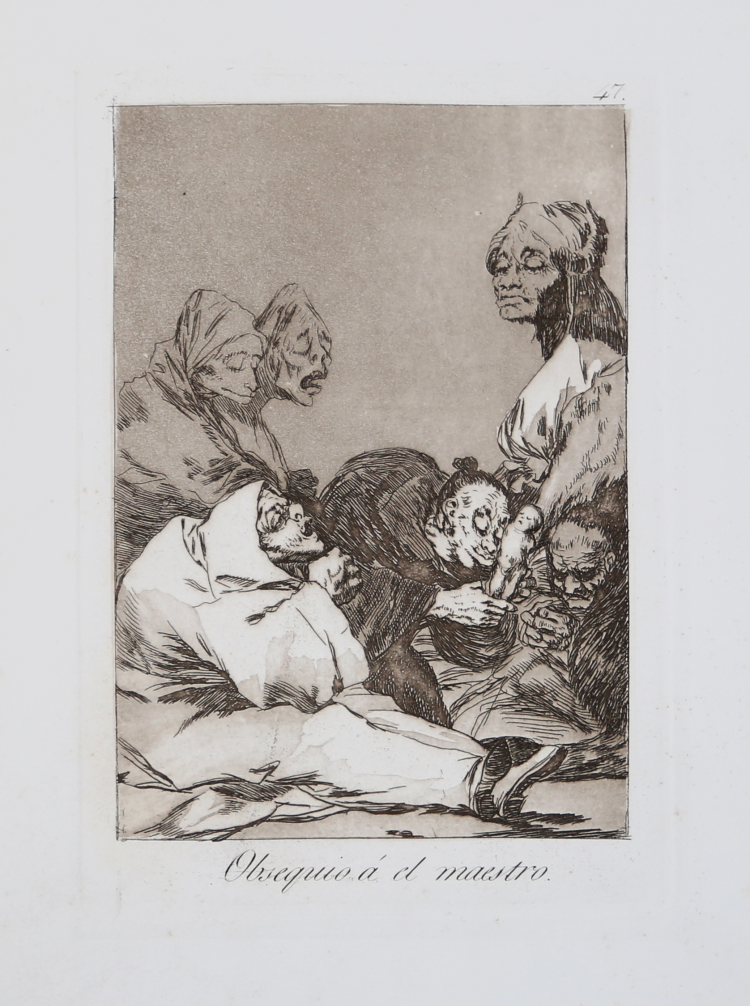



| Reference: | S7085 |
| Author | Francisco de GOYA Y Lucientes |
| Year: | 1799 ca. |
| Measures: | 150 x 125 mm |


| Reference: | S7085 |
| Author | Francisco de GOYA Y Lucientes |
| Year: | 1799 ca. |
| Measures: | 150 x 125 mm |
Etching with burnished aquatint and engraving, 1799.
From the fourth edition of twelve of the so-called "Los Caprichos" series, edited by the Madrid Calcografia [circa 1870].
A very good impression, with good contrast, printed on contemporary paper, customary margins, in very good conditions.
The series called Los Caprichos, consists of eighty etchings. This first edition of 1799, the only one not to be published posthumously, is imprinted on soft laid pape.
Cured in phase edition by the same artist, the series was marketed and before long withdrawn from the market. In fact, because of the many subjects that mocked the Spanish society of the century, Goya suffered censorship.
The interpretation of the subjects represented on these plates, always enigmatic, is often controversial.
|
Harris 82, Delteil 84.
|
Francisco de GOYA Y Lucientes (Fuente de Todos 1746 - Bordeaux 1828)
|
Spanish painter, draughtsman and printmaker. The most important Spanish artist of the last quarter of the 18th and first quarter of the 19th centuries, he served three generations of Spanish kings. Stylistically his work spans the period from the late Rococo to Romanticism and, at the last, presages Impressionism. During his six active decades he produced some 700 paintings, 900 drawings and almost 300 prints, which reflect his rapidly changing world: the Bourbon Spain of Charles III and the reign of Charles IV, the Enlightenment, the French occupation, the turmoil of the Peninsular War, the despotic reign of Ferdinand VII (and the Inquisition) and Spain’s few years of constitutional government. Appreciation of his prints by non-Spaniards even during his lifetime soon ensured his reputation abroad. Known by 1801 as the ‘Apelles of Spain’, he has been regarded since as a major master of international stature and as the first ‘modern’ artist.
|
|
Harris 82, Delteil 84.
|
Francisco de GOYA Y Lucientes (Fuente de Todos 1746 - Bordeaux 1828)
|
Spanish painter, draughtsman and printmaker. The most important Spanish artist of the last quarter of the 18th and first quarter of the 19th centuries, he served three generations of Spanish kings. Stylistically his work spans the period from the late Rococo to Romanticism and, at the last, presages Impressionism. During his six active decades he produced some 700 paintings, 900 drawings and almost 300 prints, which reflect his rapidly changing world: the Bourbon Spain of Charles III and the reign of Charles IV, the Enlightenment, the French occupation, the turmoil of the Peninsular War, the despotic reign of Ferdinand VII (and the Inquisition) and Spain’s few years of constitutional government. Appreciation of his prints by non-Spaniards even during his lifetime soon ensured his reputation abroad. Known by 1801 as the ‘Apelles of Spain’, he has been regarded since as a major master of international stature and as the first ‘modern’ artist.
|